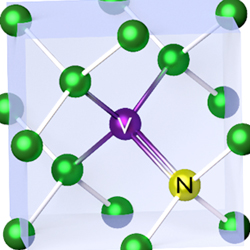Defects in Solids for Quantum Technologies
 The ability to create, manipulate and read out quantum states of matter will enable next-generation quantum technologies. Point defect quantum states in solids have applications as single photon sources, quantum bits that can be harnessed for quantum information processing, and nanoscale sensors that may revolutionize information and communication technology, biological research, and biomedical therapy. The leading platform for several quantum technologies is the nitrogen-vacancy center in diamond, which exhibits long quantum coherence times at room temperature in ambient conditions. There is significant activity aiming to develop other defects in solids, including bright single-photon emitters and spin defects based on point defects in silicon carbide (SiC), silicon (Si), two-dimensional hexagonal boron nitride (hBN), as well as rare-earth ions (REI) embedded into various solids. In parallel, spin systems based on molecules ordered in molecular crystals are also emerging platforms. These new platforms pose broad challenges in controlling material purity, quality, and fabrication, which are especially demanding for quantum applications. First-principles theoretical simulations have been demonstrated as essential tools in understanding the underlying physics of these atomic scale systems as well as in identifying potential new quantum bits and single photon emitters in these materials. Therefore, close collaboration of experimental and atomistic simulation researchers is essential for rapid progress in the field.
The ability to create, manipulate and read out quantum states of matter will enable next-generation quantum technologies. Point defect quantum states in solids have applications as single photon sources, quantum bits that can be harnessed for quantum information processing, and nanoscale sensors that may revolutionize information and communication technology, biological research, and biomedical therapy. The leading platform for several quantum technologies is the nitrogen-vacancy center in diamond, which exhibits long quantum coherence times at room temperature in ambient conditions. There is significant activity aiming to develop other defects in solids, including bright single-photon emitters and spin defects based on point defects in silicon carbide (SiC), silicon (Si), two-dimensional hexagonal boron nitride (hBN), as well as rare-earth ions (REI) embedded into various solids. In parallel, spin systems based on molecules ordered in molecular crystals are also emerging platforms. These new platforms pose broad challenges in controlling material purity, quality, and fabrication, which are especially demanding for quantum applications. First-principles theoretical simulations have been demonstrated as essential tools in understanding the underlying physics of these atomic scale systems as well as in identifying potential new quantum bits and single photon emitters in these materials. Therefore, close collaboration of experimental and atomistic simulation researchers is essential for rapid progress in the field.
The main objective of the special topic is to bring together theoreticians, computational scientists, experimentalists, and material growers working on different semiconducting systems to advance the field of point defect-based solid-state quantum technologies.
Topics covered include, but are not limited to:
- experimental and theoretical characterization of point defect single photon emitters and qubits in semiconductors and other solids.
- ab initio theory of single photon emitters and qubits, and theory of related applications.
- quantum sensing and quantum information processing applications in bulk and nano-scale systems.
- material growth for quantum technology.
Guest Editors
Adam Gali, HUN-REN Wigner Research Centre for Physics/Budapest University of Technology and Economics
Viktor Ivády, Eötvös Loránd University
Igor Abrikosov, Linkoping University
Yuan Ping, University of Wisconsin-Madison
Submission and acceptance criteria:
Authors are welcome to submit letter manuscripts limited to 3000 words to Applied Physics Letters and longer, regular articles to Journal of Applied Physics. Manuscripts submitted to either journal should report on original and timely results that significantly advance understanding in applied physics. For more information on each journal’s editorial policies, please see here: APL Editorial Policies and JAP Editorial Policies. Perspective papers are welcome at either journal. Methods, Tutorials, and Reviews are welcome at Journal of Applied Physics.
Please note that papers will be published as normal when they are ready in a regular issue of the journal and will populate on a virtual collection page within a few days of publication. Inclusion in the collection will not cause delay in publication.
